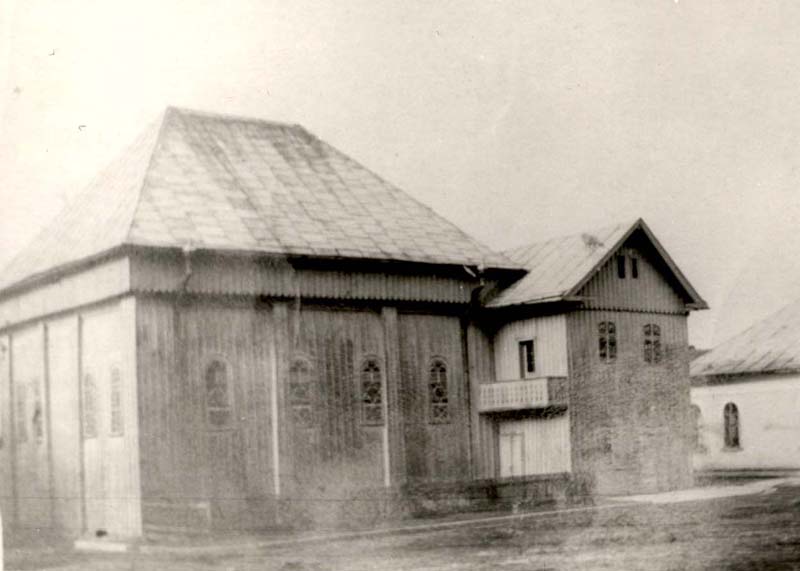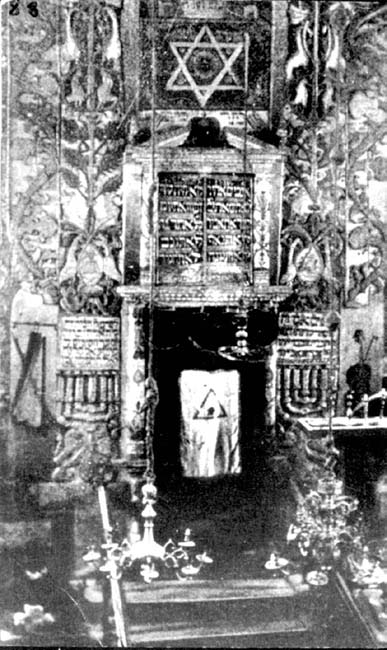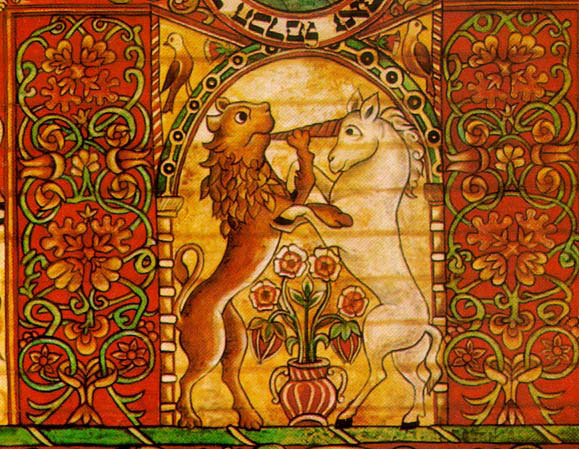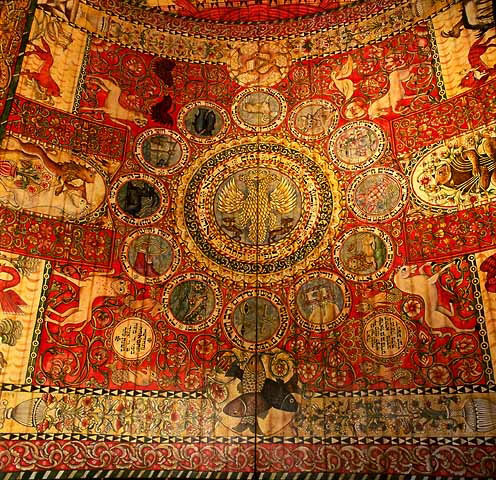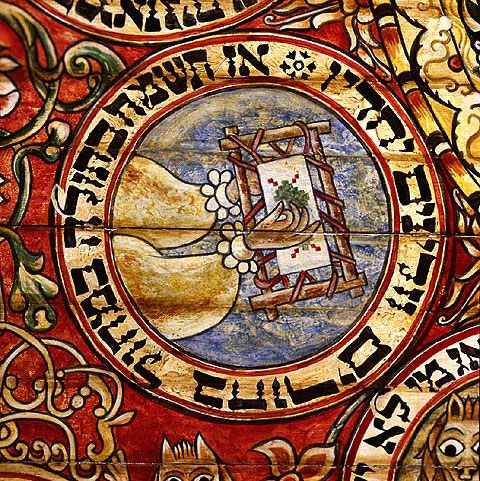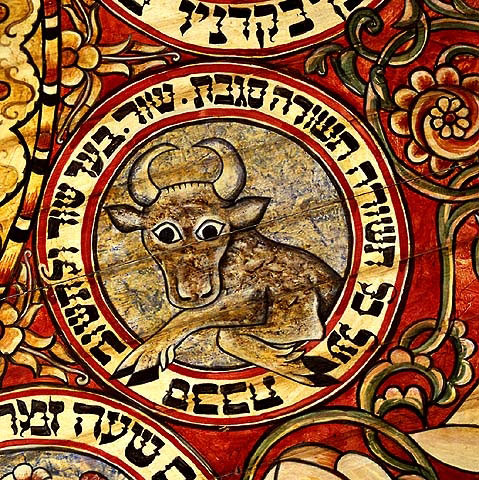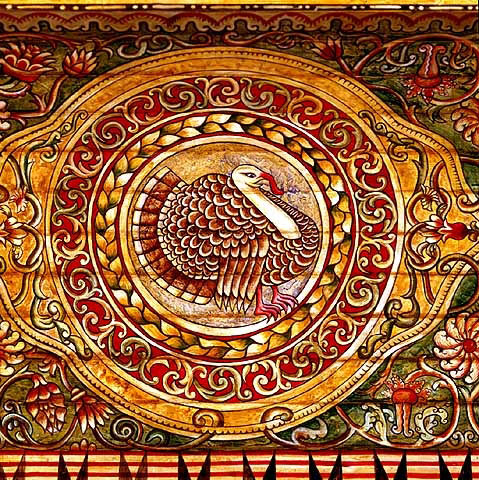- Yaffa Eliach, There Once Was a World, Little, Brown & Co., USA 1999, P. 63.
- Carl Hersh, The Lost Wooden Synagogues Of Eastern Europe [film], Close-Up Productions, Florida Atlantic University 2000.
- Eliach, p. 63.
- Hersh.
- ibid.
- Beth Hatefutsoth,The Ceiling [film].
- Hersh.
- For more examples, see: Joseph Shadur, Traditional Jewish Papercuts, Universe, USA 1999.
“Behold All That Was Painted My Hand Has Wrought”
from the painting signature by Israel ben Mordechai Lissnicki of the community of Yartshov.
“Few other places throughout the centuries have witnessed more scholarship, friendship, devotion, humility, charity, love, longing, joy, hope, tears and sorrow, than the rooms enclosed by the shtetl synagogue and the bet midrash.”1
A vividly painted lion and a unicorn, sloe-eyed and graceful, face each other as if dancing, front legs entwined. The unicorn’s head is bowed, allowing the lion to blow, trumpet-like, on its horn. Three rabbits chase each other in an endless circle, their long ears forming an inner triangle. A wise looking bear sits comfortably amidst a beautifully flowering vine, bright birds cavorting around him.
All of the animals in this delightful bestiary are painted in warm hues of red, gold, and green. Is this a description of the walls of a circus tent, the backdrop of a carnival of fantastic beasts? No.
- 1. 1
These animals are but a few that once graced the beautifully painted ceiling of the wooden synagogue of Chodorow, a shtetl in Galicia, Poland (today the Ukraine).
To our modern eyes, accustomed to synagogues decorated in a more contemporary abstract style, the use of unicorns, griffins, rabbits, monkeys, and elephants in Jewish houses of worship may seem bizarre, images not often associated with Jewish tradition or culture. After all, traditional Jewish art is often non-representational, with most Jewish cultures prohibiting the portrayal of the human body in its entirety, and in some cases, even the images of animals. And yet, in the synagogues of Poland and Eastern Europe animals and symbols abounded, painted with great ebullience and joy, turning these places into earthly showcases of the glory of the Torah (Bible), of prayer and, sometimes, the coming of the messiah.
The Chodorow synagogue, along with most of the wooden synagogues of Eastern Europe, was completely destroyed by the Nazis during the Holocaust, robbing the modern viewer of it’s rich cultural and artistic heritage. All that exists of these synagogues today are black and white photos taken in the early part of the 20th century, some carefully reconstructed models, and the recollections of the few people alive today who remember them. In the physical absence of this Jewish tradition, many contemporary Jews remain unaware of these symbols, icons and motifs that their forefathers understood, respected, and loved.
In this article we hope to offer a glimpse of what those vanished synagogues meant to the Jews who built them and prayed in them. In their absence, it falls to us to perpetuate the memory of the vibrant Jewish world they inhabited which exists no more. We will focus on the synagogue of Chodorow as representative of this theme, bearing in mind that it typifies one of hundreds of wooden synagogues in shtetls (small towns with large Jewish populations) throughout Eastern Europe.
It is thanks to Beth Hatefutsoth in Tel Aviv, and its beautifully reconstructed full- color model of the Chodorow ceiling, that we can still see and appreciate the vivid colors and artistry that once decorated the destroyed synagogue.
Built in 1652, the Chodorow synagogue was made entirely of timber, a plentiful and cheap building material in richly forested Eastern Europe. Though rather plain on the outside, many such synagogues were resplendent with bright folkloric paintings and beautifully carved bimot (pulpits) and aronei kodesh (arks that hold the Torah scroll). They were often constructed by master carpenters, and under their roofs contained ingeniously hidden architectural features, such as inner domes held up by concealed supports. The synagogue, and its attendant Jewish buildings, such as the bet midrash (house of study), rabbi’s house, and the ritual bath, stood in the “shulhof”, the synagogue square. Typically these synagogues soared above all other houses and buildings of the shtetl, defining the skyline by their presence: the very heart and soul of Jewish life in these communities.
Dr. Henry Abrahamson, a specialist in Eastern European Jewish history, succinctly describes the centrality of the wooden synagogues in the Jews’ lives:
“The wooden synagogue was the place Jews looked for direction, for focus... it was a place that channeled their energies. It was the place that they used as a fulcrum in terms of their relationship to the physical and spiritual world.”2
Yaffa Eliach, Holocaust scholar,author and founder of the Shtetel foundation, tells us, “The synagogue was the house of God and the dwelling place of every Jew. It and the bet midrash were the places where the Jewish male spent most of his life, from birth to death, making him a virtual guest in his own home.”3
And what a contrast there was between the typical shtetl Jew’s home and the synagogue! In Chodorow, like most eastern European shtetels, the population was an impoverished one, mainly living in very basic quarters. Only a handful were “balabasim” (homeowners). The modest surroundings of Jewish daily life were sharply and beautiful contrasted by the opulence of the synagogue, a true separation of the heavenly from the mundane.
The Jews of Chodorow cherished their architectural and spiritual treasure, and some felt it even defined them. Klara Flecker, a former resident of Chodorow, remembers:
“The synagogue itself, as an edifice, as a building, was the pride of our town. Wherever you went, when they asked you where you are from, you are from Chodorow. ‘Oh, you have that famous synagogue, now we know who you are!’ ”4
Indeed, entering the synagogue is often recalled by the Jews who worshipped there as an awe-inspiring, uplifting experience. In Chodorow as in many other shuls, the walls were richly painted with large prayers and psalms, making them easily readable to the seated congregants. In the middle of the room stood a raised bima [pulpit], Chodorow’s being surrounded by a balustrade of intricately woven metalwork. On the eastern wall, rose the exquisitely carved aron hakodesh – reached by 6 steps. This feature rose majestically almost to the beginning of the curve of the vaulted ceiling. And what a ceiling this was, as colorful, intricate and rich as an oriental rug, floating, almost tent-like, above the heads of the worshippers.
“Everyone was sitting down to pray and we were always wondering how beautiful the shul is, what a beauty, and who had such golden hands to do such a job,”5 recalls former Chodorow resident, Joseph Haber.
Who was the Jewish Michelangelo, who, in the year 1714, lying flat on his back high above the synagogue floor, painted this ceiling? His name was Israel Ben Mordechai Lissnicki, an itinerant Jewish artist who, unlike most synagogue artists, felt compelled to sign his work upon completion. Thus we know that his “golden hands” also painted two other synagogues in the area of Chodorow.
He would not have undertaken this long and painstaking project for financial gain. Artists who undertook these commissions did so for not much more than sleeping accommodations and a modest salary. Rather, Lissnicki did so for the artistic and spiritual satisfaction of creating beauty that would inspire all who saw it to come, for centuries.
Lissnicki specifically took his inspiration in creating his work from the Galician Jewish folk art around him, from illuminated Jewish manuscripts, from the decorated pages of printed Jewish books, from motifs found on the carved tombstones in Jewish cemeteries, and from other earlier synagogues. On the high ceiling of the synagogue, he painted the 12 signs of the zodiac, each encircled by passages from scripture and prayer.6
Dr. Henry Abrahamson tells us:
“When a Jew would walk into the synagogue, and beheld all of the signs of the zodiac, he or she would get a sense of the rhythm of the entire Jewish year, and the associations of various festivals which would be celebrated under each of the symbols...”7
The artist charmingly interpreted the zodiac symbols within the religious restrictions forbidding the display of the entire human body. For example, Virgo is represented by two forearms covered in modest sleeves, ending in a pair of delicate hands embroidering a framed cloth with flowers, a typical pastime amongst young women. Taurus features a contemplative bull, chin resting on a raised foreleg in a human manner, who engages the viewer with its almond-shaped black eyes. Surrounding these symbols, flowering vines swirl and twist seamlessly one into the other. They frame pairs of birds and animals, such as two roosters. Their early morning crowing is said to represent the righteous, by announcing the approach of god’s mercy with the eastern dawn. Two prancing unicorns face each other, horns pointing forward as they gaze steadily into each others beautiful eyes. In Jewish art, unicorns are said to represent messianic times. Indeed, in one of the panels a lion is seen blowing the horn of a unicorn: the horn is perhaps a symbol of a “shofar” heralding the coming of the messiah.
However in four prominent places on the ceiling, we see less charming scenes of animals, scenes depicting predators making off with a hapless animal victim while the rest of its kin stand helplessly by. Thus we see a baby goat in the jaws of a wolf, while three of its herd look on, a chicken in the talons of an eagle being borne away from the rest of the flock, a duck meeting the same fate, and most strikingly, a rabbit being attacked by a griffin, while its fellow rabbits gaze on in terror. At this point and place in Jewish history, rabbits are thought to represent the Jewish people, a symbol that becomes clear in light of the history of the region.
When Lissnicki painted his ceiling, barely more than half a century had passed since the horrific Chmielnitzky Massacres of 1648–1649, in which it is estimated that 100,000 Jews of the Ukraine were murdered, 1,800 synagogues destroyed, and hundreds of Jewish communities wiped out. When the worshippers viewed this theme of a predator and a victim in a cycle of violence, they were better able to conceptualize or explain their present while commemorating their tragic collective history. Perhaps these rapacious depictions also served to remind the viewer to pray more fervently for their deliverance from such earthly evil and suffering and the coming of the messiah.
- 7. 7
While contemplating the earthly and the heavenly, the congregants would see on the eastern wall an idealized depiction of Jerusalem - not a Jerusalem created from visual memory but from folk memory. The clue that this strange- looking architectural depiction is indeed Jerusalem is the two protective lions standing at either side, inviting the viewers to behold and the holy city. These lions are but a few of the many lions Lissnicki painted on the ceiling, looking out with proud wide-eyed expressions that captivate and charm the viewer. Lions are one of Judaism’s most enduring symbols, representing majesty, strength, endurance, and the tribe of Judah, the tribe from which the messiah will come. By depicting a pair of lions guarding Jerusalem, the Chodorow synagogue carries on an ancient tradition of showing lions as guardian of the Holy City , and offering the worshippers a symbol of a future redemption.
Lions, along with gazelles, eagles, and leopards, are one the most common motifs in Ashkenazi eastern European synagogues. Pirkei Avot 5:23 commands, “Be bold as a leopard, light as an eagle, swift as a deer, and strong as a lion to carry out the will of your Father in Heaven."
These animals all appear in the Chodorow synagogue, inspiring all to imitate their admirable qualities of piety. Some of these animals were not native to Poland, so again Lissnicki depicts them from popular memory and not from life. The leopard of this quartet, steadily gazing down on those who look up at him, has an almost human expression on his face, personifying the boldness he symbolizes. Various other animals and birds populate the wall around him, all of them with symbolic significance, some of which is lost to us today. We see elephants with castles on their back, which is said to represent the wisdom of the Torah. Two long-tailed monkeys also appear on the eastern wall, solemnly facing what would have been the top of the aron hakodesh (the ark). The Talmud teaches that those who see an elephant or monkey are to say a special blessing, so perhaps the presence of these two primates on the ceiling would again serve to prompt greater fervency of prayer. The abundant storks that busily surround other motifs are called “hassidim” and represent goodness and charity. Even today in Poland, storks are considered to represent goodness, and they are encouraged to build their nests next to human homes to enrich the lives of those who live there. Turkeys, geese, camels, sheep, goats, and parrots are also featured. Their symbolism is more esoteric and may simply represent common Yiddish family names of people who may have been important in the shtetl.8 For example, the amusing, sitting bear surrounded by the flowering vine mentioned at the beginning of this article may represent the Gabai of the Chodorow synagogue, who in 1714 when the ceiling was created, was a man call Reb Dov Ber. (”Dov” and "Ber” both meaning "bear" - the former in Hebrew, the latter in Yiddish.)
A thorough discussion of each and every artistic gem in the synagogue of Chodorow would require an entire volume. We must remember that there were once hundreds of wooden synagogue in eastern Europe, done in the same richly decorated tradition of carvings and paintings as Chodorow, each synagogue with its own story, each with its own history of the communities who loved and cherished them for centuries.
When the Nazis invaded Poland in 1939, one of their first soul-destroying acts against Jews was to strike at the very heart of their community, at its pride, history, and focal point. The synagogue was often the first victim - desecrated, set aflame, and destroyed in front of the shocked Jewish population and, in some horrible cases, with members of the community forced inside of them. Except for a pitiful handful of dilapidated husks in a few remote villages in Lithuania and Latvia, there is almost no trace that they ever existed.
If we feel an obligation to remember as many names and stories of human victims of the Holocaust as possible in order to perpetuate their memory, it should also be our duty to remember and honor the beautiful houses of worship they created. By doing so, we can begin to experience a taste of the joy, awe and exuberance that generations of Jews must have felt when they entered their doors.
Carl Hersh, “The Lost Wooden Synagogues Of Eastern Europe” [film], Close-Up Productions, Florida Atlantic University 2000.
Yaffa Eliach, There Once Was a World, Little, Brown & Co., USA 1999, P. 632.
Dr K Shwartz, Wooden Synagogues in Poland, Tel Aviv Museum 1941.
Joseph Shadur, Traditional Jewish Papercuts, Universe, USA 1999.
“The Ceiling” - Beth Hatefutsoth films.
- 8. 8




